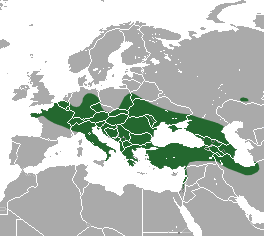Bicolored shrew facts for kids
Quick facts for kids Bicolored shrew |
|
|---|---|
 |
|
| Conservation status | |
| Scientific classification | |
| Genus: |
Crocidura
|
| Species: |
leucodon
|
 |
|
| Bicolored shrew range | |
| Synonyms | |
|
Sorex leucodon Hermann, 1780 |
|
The bicolored shrew (Crocidura leucodon) is a small mammal that lives in parts of Europe and western Asia. It's sometimes called the bicoloured white-toothed shrew because of its fur colors. These shrews are mostly active at night. They like to eat insects and other small creatures. During the warmer parts of the year, mother shrews have several groups of babies. They build their nests in hidden spots using dry grasses.
Contents
What Does a Bicolored Shrew Look Like?
The bicolored shrew is quite small. Its head and body are about 2.5 to 3.5 inches long. Its tail is also around 2.5 to 3.5 inches long. This tiny animal weighs about 7 to 13 grams.
Its fur is dark brown on its back and sides. The fur on its belly is white. There's a clear line where the two colors meet. The shrew has a long, pink nose. Its teeth are white, and its ears stick out from its fur. The tail has a few longer hairs on it. Young shrews are usually a bit lighter in color. These shrews often make a high-pitched chattering sound.
Where Do Bicolored Shrews Live?
You can find the bicolored white-toothed shrew in eastern, central, and southern Europe. However, they don't live in southwestern France, Spain, Portugal, or southern Italy. They also live in places like Crimea, the Caucasus, Turkestan, and Iran. In the Alps mountains, they can live at heights up to about 3,300 feet.
These shrews like to live in places like pastures and farm fields. They also enjoy gardens, hedgerows, and piles of rocks or trash. Sometimes, in winter, they might go inside buildings to find shelter. They usually stay away from very wet places.
How Do Bicolored Shrews Behave?
The bicolored white-toothed shrew is mostly active at night. It comes out when the sun goes down. During the day, it hides in small cracks or in burrows made by other small animals. These shrews are not as active as some other types of shrews.
They are carnivores, which means they eat meat. Their diet includes insects, spiders, and other small creatures without backbones. Sometimes, they might even eat very small animals with backbones.
Shrews breed between April and September. A mother shrew can have two to four groups of babies in a year. She builds a nest of dried grasses in a secret spot. After about 31 days, three to nine baby shrews are born. The babies grow quickly. They drink their mother's milk for about 26 days. They become old enough to have their own babies when they are about 40 days old.
When a family of young shrews feels danger, they have a special way to move. One baby will grab its mother's fur near her tail with its mouth. Then, the other babies will hold onto the tail of the one in front of them. This creates a long chain of shrews! The mother then quickly leads them to safety, with the young shrews following behind in their "conga line." If the mother is lifted, the young shrews hold on tight, dangling in a wiggling, furry chain.
Why Are Bicolored Shrews Studied?
Scientists study bicolored shrews for different reasons. For example, they can carry certain tiny germs that might affect other animals. This helps researchers understand how diseases spread among animals like sheep, horses, and cats.


